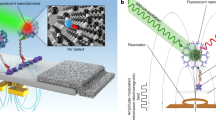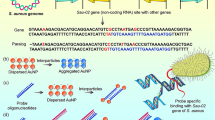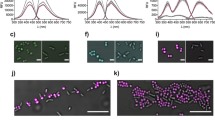Abstract
Nucleic acid diagnostics is dominated by fluorescence-based assays that use complex and expensive enzyme-based target or signal-amplification procedures1,2,3,4,5,6. Many clinical diagnostic applications will require simpler, inexpensive assays that can be done in a screening mode. We have developed a 'spot-and-read' colorimetric detection method for identifying nucleic acid sequences based on the distance-dependent optical properties of gold nanoparticles. In this assay, nucleic acid targets are recognized by DNA-modified gold probes, which undergo a color change that is visually detectable when the solutions are spotted onto an illuminated glass waveguide. This scatter-based method enables detection of zeptomole quantities of nucleic acid targets without target or signal amplification when coupled to an improved hybridization method that facilitates probe-target binding in a homogeneous format. In comparison to a previously reported absorbance-based method7, this method increases detection sensitivity by over four orders of magnitude. We have applied this method to the rapid detection of mecA in methicillin-resistant Staphylococcus aureus genomic DNA samples.
This is a preview of subscription content, access via your institution
Access options
Subscribe to this journal
Receive 12 print issues and online access
$209.00 per year
only $17.42 per issue
Buy this article
- Purchase on Springer Link
- Instant access to full article PDF
Prices may be subject to local taxes which are calculated during checkout




Similar content being viewed by others
References
Kirk, B.W., Feinsod, M., Favis, R., Kliman, R.M. & Barany, F. Single nucleotide polymorphism seeking long term association with complex disease. Nucleic Acids Res. 30, 3295–3311 (2002).
Whelen, A.C. & Persing, D.H. The role of nucleic acid amplification and detection in the clinical microbiology laboratory. Annu. Rev. Microbiol. 50, 349–373 (1996).
Bernard, P.S. & Wittwer, C.T. Real-time PCR technology for cancer diagnostics. Clin. Chem. 48, 1178–1185 (2002).
Kwok, P.Y. Methods for genotyping single nucleotide polymorphisms. Annu. Rev. Genomics Hum. Genet. 2, 235–258 (2001).
Mackay, I.M., Arden, K.E. & Nitsche, A. Real-time PCR in virology. Nucleic Acids Res. 30, 1292–1305 (2002).
Hall, J.G. et al. Sensitive detection of DNA polymorphisms by the serial invasive cleavage reaction. Proc. Natl. Acad. Sci. USA 97, 8272–8277 (2000).
Elghanian, R., Storhoff, J.J., Mucic, R.C., Letsinger, R.L. & Mirkin, C.A. Selective colorimetric detection of polynucleotides based on the distance-dependent optical properties of gold nanoparticles. Science 277, 1078–1081 (1997).
Mirkin, C.A., Letsinger, R.L., Mucic, R.C. & Storhoff, J.J. A DNA-based method for rationally assembling nanoparticles into macroscopic materials. Nature 382, 607–609 (1996).
Storhoff, J.J. et al. What Controls the Optical Properties of DNA-Linked Gold Nanoparticle Assemblies? J. Am. Chem. Soc. 122, 4640–4650 (2000).
Thanh, N.T.K. & Rosenzweig, Z. Development of an aggregation-based immunoassay for anti- protein A using gold nanoparticles. Anal. Chem. 74, 1624–1628 (2002).
Otsuka, H., Akiyama, Y., Nagasaki, Y. & Kataoka, K. Quantitative and reversible lectin-induced association of gold nanoparticles modified with alpha-lactosyl-omega-mercapto- poly(ethylene glycol). J. Am. Chem. Soc. 123, 8226–8230 (2001).
Kim, Y.J., Johnson, R.C. & Hupp, J.T. Gold nanoparticle-based sensing of “spectroscopically silent” heavy metal ions. Nano Lett. 1, 165–167 (2001).
Liu, J. & Lu, Y. A colorimetric lead biosensor using DNAzyme-directed assembly of gold nanoparticles. J. Am. Chem. Soc. 125, 6642–6643 (2003).
Storhoff, J.J., Elghanian, R., Mucic, R.C., Mirkin, C.A. & Letsinger, R.L. One-pot colorimetric differentiation of polynucleotides with single base imperfections using gold nanoparticle probes. J. Am. Chem. Soc. 120, 1959–1964 (1998).
Lazarides, A.A. & Schatz, G.C. DNA-Linked Metal Nanosphere Materials: Structural Basis for the Optical Properties. J. Phys. Chem. B 104, 460–467 (2000).
Reynolds, R.A., Mirkin, C.A. & Letsinger, R.L. Homogeneous, nanoparticle-based quantitative colorimetric detection of oligonucleotides. J. Am. Chem. Soc. 122, 3795–3796 (2000).
Sonnischen, C. et al. Spectroscopy of single metallic nanoparticles using total internal reflection spectroscopy. Appl. Phys. Lett. 77, 2949–2951 (2000).
Jin, R.C. et al. Photoinduced conversion of silver nanospheres to nanoprisms. Science 294, 1901–1903 (2001).
Stimpson, D.I. et al. Real-Time Detection of DNA Hybridization and Melting on Oligonucleotide Arrays by Using Optical-Wave Guides. Proc. Natl. Acad. Sci. USA 92, 6379–6383 (1995).
Yguerabide, J. & Yguerabide, E.E. Light-scattering submicroscopic particles as highly fluorescent analogs and their use as tracer labels in clinical and biological applications - I. Theory. Anal. Biochem. 262, 137–156 (1998).
Yguerabide, J. & Yguerabide, E.E. Light-scattering submicroscopic particles as highly fluorescent analogs and their use as tracer labels in clinical and biological applications - II. Experimental characterization. Anal. Biochem. 262, 157–176 (1998).
Taton, T.A., Lu, G. & Mirkin, C.A. Two-color labeling of oligonucleotide arrays via size-selective scattering of nanoparticle probes. J. Am. Chem. Soc. 123, 5164–5165 (2001).
Wetmur, J.G. Acceleration of DNA renaturation rates. Biopolymers 14, 2517–2524 (1975).
Chambers, H.F. Methicillin Resistance in Staphylococci: Molecular and Biochemical Basis and Clinical Implications. Clin. Microbiol. Rev. 10, 781–791 (1997).
Jenison, R., Yang, S., Haeberli, A. & Polisky, B. Interference-based detection of nucleic acid targets on optically coated silicon. Nat. Biotechnol. 19, 62–65 (2001).
Singh-Zocchi, M., Dixit, S., Ivanov, V. & Zocchi, G. Single-molecule detection of DNA hybridization. Proc. Natl. Acad. Sci. USA 100, 7605–7610 (2003).
Acknowledgements
We thank the National Institutes of Health (2 R44 CA85008-02) for support of this work. We also thank Susan Hagenow for assistance in sequence design, and the manufacturing and engineering groups at Nanosphere for technical support.
Author information
Authors and Affiliations
Corresponding author
Ethics declarations
Competing interests
Nanosphere is a privately held company, and publication of the manuscript demonstrates scientific progress that could lead to future funding for the company.
Rights and permissions
About this article
Cite this article
Storhoff, J., Lucas, A., Garimella, V. et al. Homogeneous detection of unamplified genomic DNA sequences based on colorimetric scatter of gold nanoparticle probes. Nat Biotechnol 22, 883–887 (2004). https://doi.org/10.1038/nbt977
Received:
Accepted:
Published:
Issue Date:
DOI: https://doi.org/10.1038/nbt977
This article is cited by
-
Development of loop-mediated isothermal amplification (LAMP) assay using SYBR safe and gold-nanoparticle probe for detection of Leishmania in HIV patients
Scientific Reports (2021)
-
Plasmonic gold nanostructures for biosensing and bioimaging
Microchimica Acta (2021)
-
Sensitive and selective detection of DNA fragments associated with Ganoderma boninense by DNA-nanoparticle conjugate hybridisation
Journal of Materials Science (2020)



